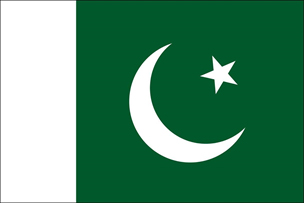Population
With a population of 212 million, Pakistan is the 6th most populous country in the world today. Its capital Islamabad is often considered one of the most beautiful capitals in the world . Ka-rachi is the biggest city with 24 million inhabitants. The population is widely diverse in ethnici-ties, languages and religions. While the official language is English and the national language is Urdu, many other native languages are spoken. Predominant religion in “The Land of the Pure” is Islam, with the majority being Sunni Muslims. The many religious minorities are sym-bolised by the white band in the flag.

Geography
Pakistan is a country in South Asia spanning from the Gulf of Oman in the South West to the Himalayas in the North East. It is home to the K2, the world’s second highest mountain. Due to this geography, climate can range from heat and humidity to year-round snow-covered mountain tops. Temperatures below 0°C in winter and 40°C in summer are common. The Indus River runs lengthwise through the country, connecting all major cities.

History
The land occupied by modern Pakistan has always been marked by influences and con-quests from East and West. It has always been
a region where cultures mix and integrate, and more than one world religion were born there.
Pakistan’s 5,000-year-old history begins with the Indus Valley Civilization, a culture famous for its advanced city planning and peacefulness. Their cities
were built in a unique architec-tural style that allowed wind to circulate and acted as natural air-conditioning. Archaeologists found almost no weapons or
evidence of warfare. The Indus Valley civilization was trading cotton cloth as early as 3,500 BC in exchange for bronze from Mesopotamia.
Following the demise of the Indus Valley Civilisation, most likely caused by climate change, the area became populated by a number of Vedic tribes,
whose culture later led to the estab-lishment of Hinduism. In 518 BC, the valley was conquered by Persians; 200 years later by Alexander the Great.
While his empire did not last long, Greek culture continued to influence the region for centuries and mixed with Indian culture. After conquest and
integration into the Umayyad Caliphate, people gradually converted to Islam, which became official state religion in the 10th century. Under the Delhi
Sultanate, the region integrated Islamic and Indian culture.
After Mongol attacks in the 13th and 14th century, the Mughal empire became dominant, dur-ing which the Sikh religion came into being. It was
a time of great economic progress and architecture. Many important buildings like palaces, forts and mausoleums from that era can still be found in Pakistan,
such as the extensive Lahore fort that contains 21 notable monu-ments.
Zulfikar Ali Bhutto. Benazir Bhutto from the socialist PPP became the country’s first female prime minister in 1988. Since then, leadership has mainly alternated
between the PPP and the conservative PML-N. In 1999, General Musharraf assumed power after a coup d’état, and held general elections three years later. Benazir Bhutto
was assassinated during a terrorist attack claimed by Al-Qaida in 2007.
Politics
Today, the constitution adopted in 1973 and reinstated in 1985 is the most important docu-ment that stipulates
Pakistan as a democratic parliamentary federal republic, with Islam as the state religion. Major parties are centre-right Pakistan Muslim
League-Nawaz (PML-N), largely popular in Punjab, the secular and centre-left socialist party Pakistan’s People’s Party (PPP), founded by Zulfiqar Ali
Bhutto, and Pakistan Tehreek-e-Insaf (PTI). PTI self-declares its stance as “anti-status quo” and aims to establish an “Islamic welfare state”. In the 2018
general elections, the PTI rose to power with 116/272 seats in parliament and forming a ma-jority with the help of several smaller parties. Imran Khan, once a
prominent cricket player and leader of PTI, now serves as the Prime Minister, Arif Alvi as president.
Economy and Development
While the current GDP is relatively low (5.400$ per capita), it is rapidly increasing. Since 1990, the GDP has grown from US$ 329 billion to $992 billion in 2017.
In 2018, GDP growth rate was 5.8%. Unemployment is only 5.7%, although underemployment remains an issue. Similarly, Pakistan’s Human Development Index is steadily
improving, from 0.404/1 to 0.562 today . However, there are large regional disparities, so that the main cities (Islamabad, La-hore, Karachi) and surrounding regions
have already reached an HDI of over 0.8. Besides a growing middle class, a booming retail sector and strong stock market contribute to the coun-try’s economic growth.
In recent years, Pakistan has been attracting large foreign investment sums from the UAE, Saudi Arabia and China. China is particularly active in the country to
construct the China-Pakistan Economic Corridor (2017-2030) as part of the Belt and Road Initiative. According to the World Bank, net exports are expected to increase
gradually.
Economic development has also improved the general livelihood of Pakistanis. In less than two decades, the percentage of the population living below the poverty
line dropped from 64% in 2001 to 24% in 2015. Whereas in 1990, only 45% of the rural population had access to electricity, it is now 99% . Life expectancy has improved
by six years in the same time. Mean years of schooling have more than doubled, and the gender development index (comprising gender equality, services and opportunities
for women) has gone up to 0.750/1 from 0.599 in 1990.
Pakistan is a land of opportunity with a promising future ahead. The national Board of Invest-ment promotes investment in Pakistan by underling its strategic location,
large, young, edu-cated workforce, high English proficiency, strong middle class and rapidly expanding con-sumer market. During the global economic crisis, Pakistan
showed its resilience. The gov-ernment is welcoming foreign direct investment with a favourable investment policy and spe-cial economic zones.

